Need help? We're here to assist you!
Thank You for Enquiry, we will contact you soon!
Close
The Class 9 is an important year in a student’s life and Maths is one of the subjects that require dedication, hard work, and practice. It’s a subject where you can score well if you are well-versed with the concepts, remember the important formulas and solving methods, and have done an ample amount of practice. Worry not! Home Revise is here to make your Class 9 journey even easier. It’s essential for students to have the right study material and notes to prepare for their board examinations, and through Home Revise, you can cover all the fundamental topics in the subject and the complete NCERT Class 9 Maths Book syllabus.

1. Give five examples of data that you can collect from your day-to-day life.
Solution:
Five examples from day-to-day life are
2. Classify the data in Q.1 above as primary or secondary data.
Solution:
Primary data: When the information was collected by the investigator themselves with a definite objective in their mind, the data obtained is called primary data.
Primary data; (i), (ii) and (iii)
Secondary data: When the information was gathered from a source which already had the information stored, the data obtained is called secondary data.
Secondary data; (iv) and (v)
1. The blood groups of 30 students of Class VIII are recorded as follows.
A, B, O, O, AB, O, A, O, B, A, O, B, A, O, O,
A, AB, O, A, A, O, O, AB, B, A, O, B, A, B, O.
Represent this data in the form of a frequency distribution table. Which is the most common, and which is the rarest, blood group among these students?
Solution:
Frequency is the number of students having the same blood group. The frequency is represented in the table or the frequency distribution table.
| Blood Group | Number of Students (Frequency) |
| A | 9 |
| B | 6 |
| O | 12 |
| AB | 3 |
| Total | 30 |
The most common Blood Group is the blood group with the highest frequency: O
The rarest Blood Group is the blood group with the lowest frequency: AB
2. The distance (in km) of 40 engineers from their residence to their place of work was found as follows:
5 3 10 20 25 11 13 7 12 31
19 10 12 17 18 11 32 17 16 2
7 9 7 8 3 5 12 15 18 3
12 14 2 9 6 15 15 7 6 12
Construct a grouped frequency distribution table with class size 5 for the data given above, taking the first interval as 0-5 (5 not included). What main features do you observe from this tabular representation?
Solution:
Since the given data is very large, we construct a grouped frequency distribution table of class size 5. ∴ , class intervals will be 0-5, 5-10, 10-15, 15-20 and so on. The data is represented in the grouped frequency distribution table as

In the given table, the classes do not overlap. Also, we find that the houses of 36 out of 40 engineers are below 20 km of distance.
3. The relative humidity (in %) of a certain city for a month of 30 days was as follows:
98.1 98.6 99.2 90.3 86.5 95.3 92.9 96.3 94.2 95.1
89.2 92.3 97.1 93.5 92.7 95.1 97.2 93.3 95.2 97.3
96.2 92.1 84.9 90.2 95.7 98.3 97.3 96.1 92.1 89
(i) Construct a grouped frequency distribution table with classes 84 – 86, 86 – 88, etc.
(ii) Which month or season do you think this data is about?
(iii) What is the range of this data?
Solution:
(i) Since the given data is very large, we construct a grouped frequency distribution table of class size 2.
∴ , class intervals will be 84-86, 86-88, 88-90, 90-92 and so on. The data is represented in the grouped frequency distribution table as
| Relative humidity (in %) | Frequency |
| 84-86 | 1 |
| 86-88 | 1 |
| 88-90 | 2 |
| 90-92 | 2 |
| 92-94 | 7 |
| 94-96 | 6 |
| 96-98 | 7 |
| 98-100 | 4 |
| Total | 30 |
(ii) The humidity is very high in the given data. Since the humidity is observed to be high during the rainy season, the data here must be about the rainy season.
(iii) The range of a data = The maximum value of the data – minimum value of the data
= 99.2−84.9
= 14.3
4
.
The heights of 50 students, measured to the nearest centimetres, have been found to be as follows:
161 150 154 165 168 161 154 162 150 151
162 164 171 165 158 154 156 172 160 170
153 159 161 170 162 165 166 168 165 164
154 152 153 156 158 162 160 161 173 166
161 159 162 167 168 159 158 153 154 159
(i) Represent the data given above by a grouped frequency distribution table, taking the class intervals as 160 – 165, 165 – 170, etc.
(ii) What can you conclude about their heights from the table?
Solution:
(i) The data given in the question can be represented by a grouped frequency distribution table, taking the class intervals as 160 – 165, 165 – 170, etc., as
| Height (in cm) |
No. of Students
(Frequency) |
| 150-155 | 12 |
| 155-160 | 9 |
| 160-165 | 14 |
| 165-170 | 10 |
| 170-175 | 5 |
| Total | 50 |
(ii) It can be concluded from the given data and the table that 35 students, i.e., more than 50% of the total students, are shorter than 165 cm.
5. A study was conducted to find out the concentration of sulphur dioxide in the air in parts per million (ppm) of a certain city. The data obtained for 30 days is as follows:
0.03 0.08 0.08 0.09 0.04 0.17
0.16 0.05 0.02 0.06 0.18 0.20
0.11 0.08 0.12 0.13 0.22 0.07
0.08 0.01 0.10 0.06 0.09 0.18
0.11 0.07 0.05 0.07 0.01 0.04
(i) Make a grouped frequency distribution table for this data with class intervals as 0.00 – 0.04, 0.04 – 0.08, and so on.
(ii) For how many days was the concentration of Sulphur dioxide more than 0.11 parts per million?
Solution:
(i) The grouped frequency distribution table for the data given in the question with class intervals as 0.00 – 0.04, 0.04 – 0.08, and so on is given below.
|
The concentration of sulphur dioxide in the air
(in ppm) |
Frequency |
| 0.00 − 0.04 | 4 |
| 0.04 − 0.08 | 9 |
| 0.08 − 0.12 | 9 |
| 0.12 − 0.16 | 2 |
| 0.16 − 0.20 | 4 |
| 0.20 − 0.24 | 2 |
| Total | 30 |
(ii) The number of days in which the concentration of sulphur dioxide was more than 0.11 parts per million = 2+4+ 2 = 8
6. Three coins were tossed 30 times simultaneously. Each time the number of heads occurring was noted down as follows:
0 1 2 2 1 2 3 1 3 0
1 3 1 1 2 2 0 1 2 1
3 0 0 1 1 2 3 2 2 0
Prepare a frequency distribution table for the data given above.
Solution:
The frequency distribution table for the data given in the question is given below.
| Number of Heads | Frequency |
| 0 | 6 |
| 1 | 10 |
| 2 | 9 |
| 3 | 5 |
| Total | 30 |
7. The value of π up to 50 decimal places is given below:
3.14159265358979323846264338327950288419716939937510
(i) Make a frequency distribution of the digits from 0 to 9 after the decimal point.
(ii) What are the most and the least frequently occurring digits?
Solution:
(i) The frequency distribution of the digits from 0 to 9 after the decimal point is given in the table below.
| Digits | Frequency |
| 0 | 2 |
| 1 | 5 |
| 2 | 5 |
| 3 | 8 |
| 4 | 4 |
| 5 | 5 |
| 6 | 4 |
| 7 | 4 |
| 8 | 5 |
| 9 | 8 |
| Total | 50 |
(ii) The digit having the least frequency occurs the least. Since 0 occurs only twice, it has a frequency of 2. ∴ , the least frequently occurring digit is 0.
The digit with the highest frequency occurs the most. Since 3 and 9 occur eight times, it has a frequency of 8. ∴ , the most frequently occurring digits are 3 and 9.
8. Thirty children were asked about the number of hours they watched TV programmes in the previous week. The results were found as follows:
1 6 2 3 5 12 5 8 4 8
10 3 4 12 2 8 15 1 17 6
3 2 8 5 9 6 8 7 14 12
(i) Make a grouped frequency distribution table for this data, taking class width 5 and one of the class intervals 5-10.
(ii) How many children have watched television for 15 or more hours a week?
Solution:
(i) The grouped frequency distribution table for the data given in the question, taking class width 5 and one of the class intervals as 5-10, is given below.
| Number of Hours | Frequency |
| 0-5 | 10 |
| 5-10 | 13 |
| 10-15 | 5 |
| 15-20 | 2 |
| Total | 30 |
(ii) From the given table, we can conclude that 2 children watched television for 15 or more hours a week.
9. A company manufactures car batteries of a particular type. The lives (in years) of 40 such batteries were recorded as follows:
2.6 3.0 3.7 3.2 2.2 4.1 3.5 4.5
3.5 2.3 3.2 3.4 3.8 3.2 4.6 3.7
2.5 4.4 3.4 3.3 2.9 3.0 4.3 2.8
3.5 3.2 3.9 3.2 3.2 3.1 3.7 3.4
4.6 3.8 3.2 2.6 3.5 4.2 2.9 3.6
Construct a grouped frequency distribution table for this data, using class intervals of size 0.5 starting from interval 2 – 2.5.
Solution:
The grouped frequency distribution table for the data given in the table, using class intervals of size 0.5 starting from interval 2 – 2.5, is given below.
| Lives of batteries (in years) |
No. of batteries
(Frequency) |
| 2-2.5 | 2 |
| 2.5-3 | 6 |
| 3-3.5 | 14 |
| 3.5-4 | 11 |
| 4-4.5 | 4 |
| 4.5-5 | 3 |
| Total | 40 |
1. A survey conducted by an organisation for the cause of illness and death among the women between the ages 15 – 44 (in years) worldwide found the following figures (in %):
| S.No. | Causes | Female fatality rate (%) |
| 1. | Reproductive health conditions | 31.8 |
| 2. | Neuropsychiatric conditions | 25.4 |
| 3. | Injuries | 12.4 |
| 4. | Cardiovascular conditions | 4.3 |
| 5. | Respiratory conditions | 4.1 |
| 6. | Other causes | 22.0 |
(i) Represent the information given above graphically.
(ii) Which condition is the major cause of women’s ill health and death worldwide?
(iii) Try to find out, with the help of your teacher, any two factors which play a major role in the cause in (ii) above being the major cause.
Solution:
(i) The information given in the question is represented below graphically.
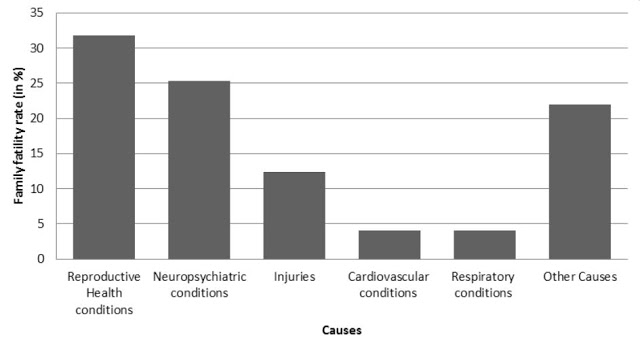
(ii) We can observe from the graph that reproductive health conditions are the major cause of women’s ill health and death worldwide.
(iii) Two factors responsible for the cause in (ii) are
2. The following data on the number of girls (to the nearest ten) per thousand boys in different sections of Indian society are given below.
| S.No. | Section | Number of girls per thousand boys |
| 1. | Scheduled Caste (SC) | 940 |
| 2. | Scheduled Tribe (ST) | 970 |
| 3. | Non-SC/ST | 920 |
| 4. | Backward districts | 950 |
| 5. | Non-backward districts | 920 |
| 6. | Rural | 930 |
| 7. | Urban | 910 |
(i) Represent the information above by a bar graph.
(ii) In the classroom, discuss what conclusions can be arrived at from the graph.
Solution:
(i) The information given in the question is represented below graphically.
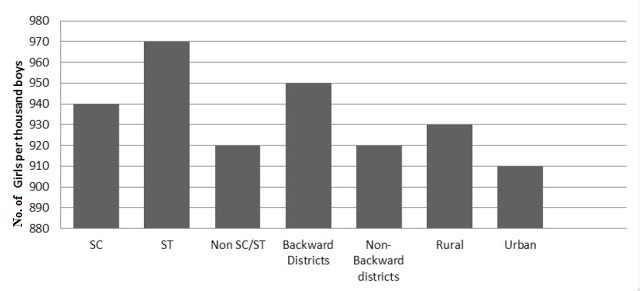
(ii) From the above graph, we can conclude that the maximum number of girls per thousand boys is present in section ST. We can also observe that the backward districts and rural areas have more girls per thousand boys than non-backward districts and urban areas.
3. Given below are the seats won by different political parties in the polling outcome of state assembly elections:
| Political party | A | B | C | D | E | F |
| Seats won | 75 | 55 | 37 | 29 | 10 | 37 |
(i) Draw a bar graph to represent the polling results.
(ii) Which political party won the maximum number of seats?
Solution:
(i) The bar graph representing the polling results is given below.

(ii) From the bar graph, it is clear that Party A won the maximum number of seats.
4. The length of 40 leaves of a plant is measured correctly to one millimetre, and the obtained data is represented in the following table:
| S.No. | Length (in mm) | Number of leaves |
| 1. | 118 – 126 | 3 |
| 2. | 127 – 135 | 5 |
| 3. | 136 – 144 | 9 |
| 4. | 145 – 153 | 12 |
| 5. | 154 – 162 | 5 |
| 6. | 163 – 171 | 4 |
| 7. | 172 – 180 | 2 |
(i) Draw a histogram to represent the given data. [Hint: First, make the class intervals continuous.]
(ii) Is there any other suitable graphical representation for the same data?
(iii) Is it correct to conclude that the maximum number of leaves is 153 mm long? Why?
Solution:
(i) The data given in the question is represented in the discontinuous class interval. So, we have to make it in the continuous class interval. The difference is 1, so taking half of 1, we subtract ½ = 0.5 from the lower limit and add 0.5 to the upper limit. Then, the table becomes
| S.No. | Length (in mm) | Number of leaves |
| 1. | 117.5 – 126.5 | 3 |
| 2. | 126.5 – 135.5 | 5 |
| 3. | 135.5 – 144.5 | 9 |
| 4. | 144.5 – 153.5 | 12 |
| 5. | 153.5 – 162.5 | 5 |
| 6. | 162.5 – 171.5 | 4 |
| 7. | 171.5 – 180.5 | 2 |
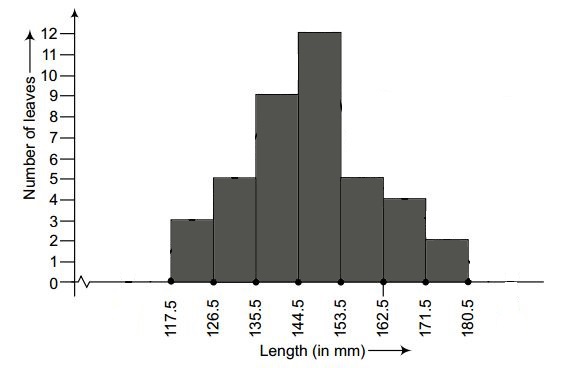
(ii) Yes, the data given in the question can also be represented by a frequency polygon.
(iii) No, we cannot conclude that the maximum number of leaves is 153 mm long because the maximum number of leaves are lying in-between the length of 144.5 – 153.5
5. The following table gives the lifetimes of 400 neon lamps.
| Life Time (in hours) | Number of Lamps |
| 300 – 400 | 14 |
| 400 – 500 | 56 |
| 500 – 600 | 60 |
| 600 – 700 | 86 |
| 700 – 800 | 74 |
| 800 – 900 | 62 |
| 900 – 1000 | 48 |
(i) Represent the given information with the help of a histogram.
(ii) How many lamps have a lifetime of more than 700 hours?
Solution:
(i) The histogram representation of the given data is given below.
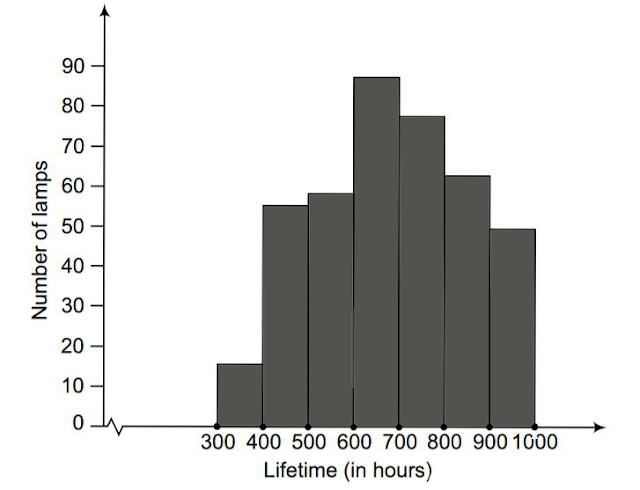
(ii) The number of lamps having a lifetime of more than 700 hours = 74+62+48 = 184
6. The following table gives the distribution of students in two sections according to the marks obtained by them.

Represent the marks of the students of both sections on the same graph by two frequency polygons. From the two polygons, compare the performance of the two sections.
Solution:
The class-marks = (lower limit + upper limit)/2
For section A,
| Marks | Class-marks | Frequency |
| 0-10 | 5 | 3 |
| 10-20 | 15 | 9 |
| 20-30 | 25 | 17 |
| 30-40 | 35 | 12 |
| 40-50 | 45 | 9 |
For section B,
| Marks | Class-marks | Frequency |
| 0-10 | 5 | 5 |
| 10-20 | 15 | 19 |
| 20-30 | 25 | 15 |
| 30-40 | 35 | 10 |
| 40-50 | 45 | 1 |
Representing these data on a graph using two frequency polygon, we get
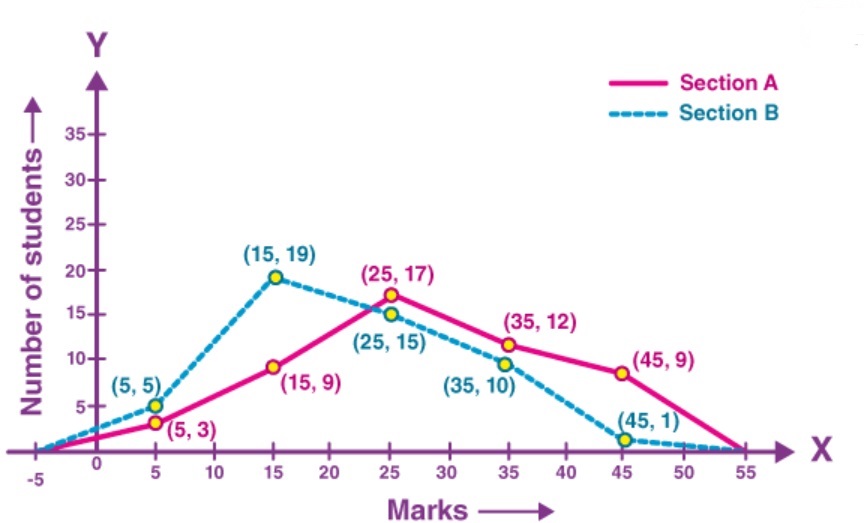
From the graph, we can conclude that the students of Section A performed better than Section B.
7 . The runs scored by two teams, A and B, on the first 60 balls in a cricket match are given below.
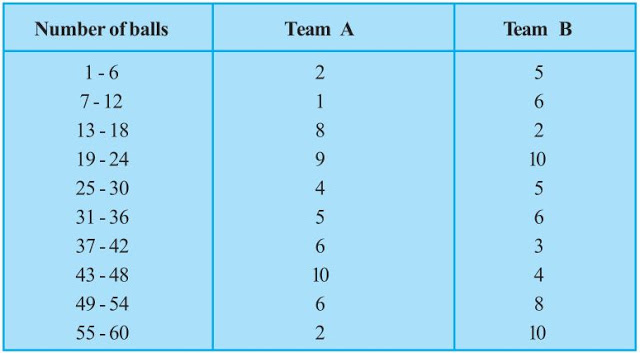
Represent the data of both teams on the same graph by frequency polygons.
[Hint: First, make the class intervals continuous.]
Solution:
The data given in the question is represented in the discontinuous class interval. So, we have to make it in the continuous class interval. The difference is 1, so taking half of 1, we subtract ½ = 0.5 = 0.5 from the lower limit and add 0.5 to the upper limit. Then, the table becomes
| Number of Balls | Class Mark | Team A | Team B |
| 0.5-6.5 | 3.5 | 2 | 5 |
| 6.5-12.5 | 9.5 | 1 | 6 |
| 12.5-18.5 | 15.5 | 8 | 2 |
| 18.5-24.5 | 21.5 | 9 | 10 |
| 24.5-30.5 | 27.5 | 4 | 5 |
| 30.5-36.5 | 33.5 | 5 | 6 |
| 36.5-42.5 | 39.5 | 6 | 3 |
| 42.5-48.5 | 45.5 | 10 | 4 |
| 48.5-54.5 | 51.5 | 6 | 8 |
| 54.5-60.5 | 57.5 | 2 | 10 |
The data of both teams are represented on the graph below by frequency polygons.
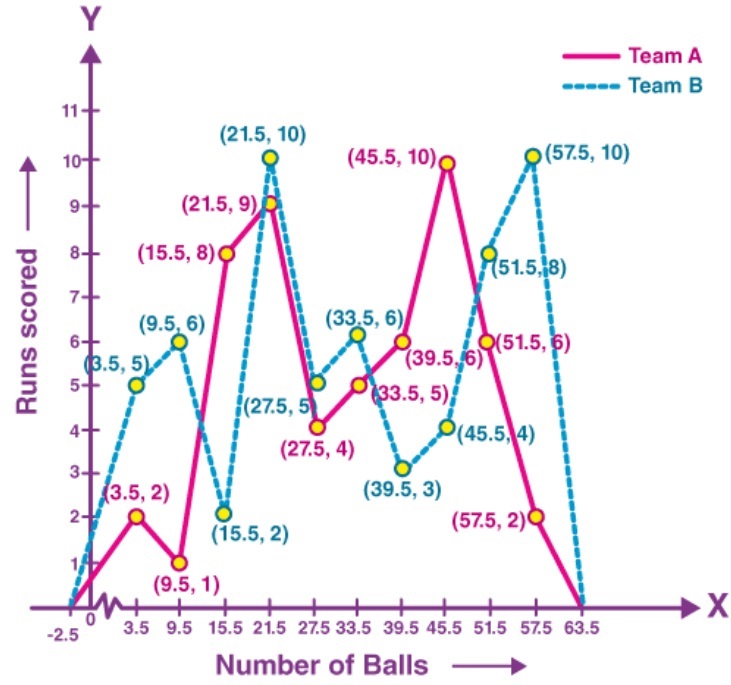
8. A random survey of the number of children of various age groups playing in a park was found as follows:
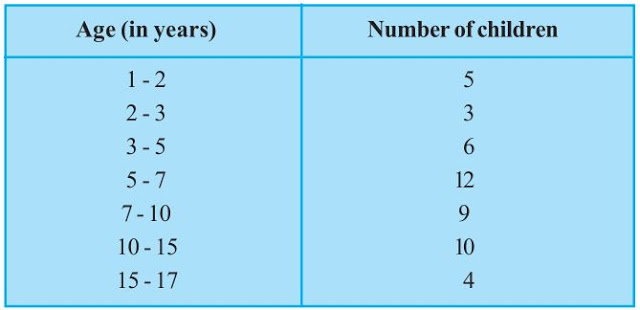
Draw a histogram to represent the data above.
Solution:
The width of the class intervals in the given data varies.
We know that,
The area of the rectangle is proportional to the frequencies in the histogram.
Thus, the proportion of children per year can be calculated as given in the table below.
|
Age
(in years) |
Number of children (frequency) | Width of class | Length of rectangle |
| 1-2 | 5 | 1 | (5/1)×1 = 5 |
| 2-3 | 3 | 1 | (3/1)×1 = 3 |
| 3-5 | 6 | 2 | (6/2)×1 = 3 |
| 5-7 | 12 | 2 | (12/2)×1 = 6 |
| 7-10 | 9 | 3 | (9/3)×1 = 3 |
| 10-15 | 10 | 5 | (10/5)×1 = 2 |
| 15-17 | 4 | 2 | (4/2)×1 = 2 |
Let x-axis = the age of children
y-axis = proportion of children per 1-year interval

9. 100 surnames were randomly picked up from a local telephone directory, and a frequency distribution of the number of letters in the English alphabet in the surnames was found as follows:
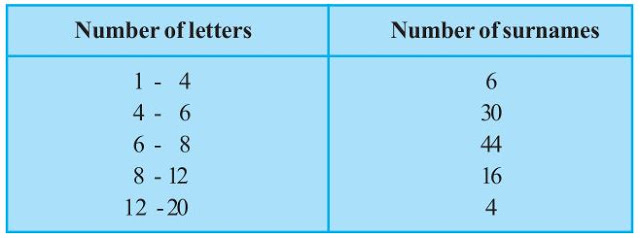
(i) Draw a histogram to depict the given information.
(ii) Write the class interval in which the maximum number of surnames lie.
Solution:
(i) The width of the class intervals in the given data is varying.
We know that,
The area of the rectangle is proportional to the frequencies in the histogram.
Thus, the proportion of the number of surnames per 2 letters interval can be calculated as given in the table below.
| Number of letters | Number of surnames | Width of class | Length of rectangle |
| 1-4 | 6 | 3 | (6/3)×2 = 4 |
| 4-6 | 30 | 2 | (30/2)×2 = 30 |
| 6-8 | 44 | 2 | (44/2)×2 = 44 |
| 8-12 | 16 | 4 | (16/4)×2 = 8 |
| 12-20 | 4 | 8 | (4/8)×2 = 1 |

(ii) 6-8 is the class interval in which the maximum number of surnames lie.
1. The following number of goals were scored by a team in a series of 10 matches:
2, 3, 4, 5, 0, 1, 3, 3, 4, 3
Find the mean, median and mode of these scores.
Solution:
Mean = Average = Sum of all the observations/Total number of observations
= (2+3+4+5+0+1+3+3+4+3)/10
= 28/10
= 2.8
Median
To find the median, we first arrange the data in ascending order.
0, 1, 2, 3, 3, 3, 3, 4, 4, 5
Here,
Number of observations (n) = 10
Since the number of observations is even, the median can be calculated as
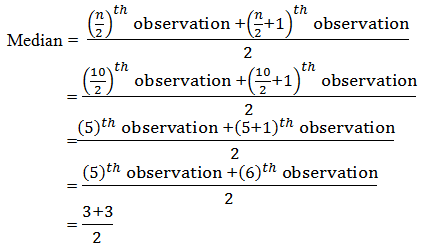
= 3
Mode
To find the mode, we first arrange the data in ascending order.
0, 1, 2, 3, 3, 3, 3, 4, 4, 5
Here,
We find that 3 occurs most frequently (4 times).
∴ Mode = 3
2. In a mathematics test given to 15 students, the following marks (out of 100) are recorded.
41, 39, 48, 52, 46, 62, 54, 40, 96, 52, 98, 40, 42, 52, 60
Find the mean, median and mode of this data.
Solution:
Mean=Average = Sum of all the observations/Total number of observations
= (41+39+48+52+46+62+54+40+96+52+98+40+42+52+60)/15
= 822/15
= 54.8
Median
To find the median, we first arrange the data in ascending order.
39, 40, 40, 41, 42, 46, 48, 52, 52, 52, 54, 60, 62, 96, 98
Here,
Number of observations (n) = 15
Since the number of observations is odd, the median can be calculated as
Median = [(n+1)/2]th observation
= [(15+1)/2]th observation
= (16/2)th observation
= 8th observation
= 52
Mode
To find the mode, we first arrange the data in ascending order.
39, 40, 40, 41, 42, 46, 48, 52, 52, 52, 54, 60, 62, 96, 98
Here,
We find that 52 occurs most frequently (3 times).
∴ Mode = 52
3. The following observations have been arranged in ascending order. If the median of the data is 63, find the value of x.
29, 32, 48, 50, x, x+2, 72, 78, 84, 95
Solution:
Number of observations (n) = 10
Given that Median = 63
Since the number of observations is even, the median can be calculated as

63 = [5th observation+(5+1)th observation]/2
63 = [5th observation+6th observation]/2
63 = (x+x+2)/2
63 = (2x+2)/2
x = 63-1
x = 62
4. Find the mode of 14, 25, 14, 28, 18, 17, 18, 14, 23, 22, 14, 18.
Solution:
Mode
To find the mode, we first arrange the given data in ascending order.
14,14,14,14,17,18,18,18,22,23,25,28
Here,
We find that 14 occurs most frequently (4 times).
∴ Mode = 14
5. Find the mean salary of 60 workers in a factory from the following table.
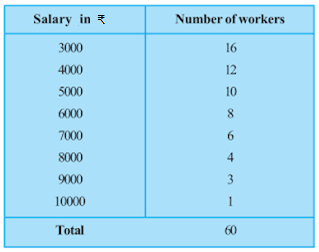
Solution:
| Salary (xi ) | Number of workers (fi ) | fi xi |
| 3000 | 16 | 48000 |
| 4000 | 12 | 48000 |
| 5000 | 10 | 50000 |
| 6000 | 8 | 48000 |
| 7000 | 6 | 42000 |
| 8000 | 4 | 32000 |
| 9000 | 3 | 27000 |
| 10000 | 1 | 10000 |
| Total | Σfi = 60 | Σfi xi = 305000 |

The mean salary is ₹5083.33
6. Give one example of a situation in which
(i) the mean is an appropriate measure of central tendency.
(ii) the mean is not an appropriate measure of central tendency, but the median is an appropriate measure of central tendency.
Solution:
(i) Mean marks obtained in the examination
(ii) Runs scored by Mahendra Singh Dhoni in 7 matches are
39, 51, 56, 102, 83, 48, 91
Here,
Mean = (39+51+56+102+83+48+91)/7
= 470/7
= 67.1.
Median,
Arranging in ascending order, we get 39, 48, 51, 56, 83, 91, 102
n = 7
Median = [(n+1)/2]th observation
= ( (7+1)/2)th observation
= (8/2)th observation
= 4th observation
= 56